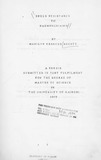| dc.description.abstract | Experiments were conducted to examine the nature of br ccd
resistance to infection with Haemonchus cont or-tu s . Two br ccd s
of sheep were chosen, Merinos - an exotic breed recently
introduced into East Africa and Red Maasa i - an indigenous
breed. To avoid differences in resistance linked to hae moglob m
type, all sheep were of haemoglobin type B.
In the fir st section two experiments are de scribed, one us 111,1.',
a 'Merino-adapted'strain of H. contortus and the other a
'Maasai-adapted'strain. No differences in response to the worm
strain were noted in either breed so differences in response to
infeCtion between the breeds were assumed to be entirely due to
the genetic make-up of the host. Response to infection was
monitored using a combination of clinical, parasitological and
radio- isotopic techniques .. The sheep were all adults reared on
contaminated pasture and thus previously exposed to H. contortu s .
The Maasai breed was shown to harbour fewer Haemonchus
worms than the Merinos and thus exhibited a milder disease
syndrome than their Merino counterparts. Serial kills showed
that initial establishment of worms was identical in both breeds
but between 16 and .18 days after infection a period of worm
expulsion occurred which resulted in a reduction in worm
numbers to 4%of the infective dose. in the Maa sai but to only 377~
in the Merinos. The resulting clinical syndrome was
proportional to worm burden and there was no evidence that the greater resistance of the Maasai was due to some superior
compensatory mechanism.
The Merinos presented a ty pic a 1 picture of haemonchosis,
namely hypercatabolism of albumin and a marked anaemia due t o
gastro- intestinal haemorrhage caused by the ha crnophag ic ill' II v I'Y
of the worms. The anaemia was normocytic LIndnor-moc hr omr.:
later becoming macrocytic due to the release of large numbers of
reticulocytes. The course and nature of the disease recorded
was in agreement with that of other author s .
The difference in the pathogenesis of the disease between
the two breeds of sheep was therefore due to the greater worm
expulsion by the Red Maasai between 16 and 18 days after
infection.
Further differences not ic ed between the breeds were
assumed to be due to a greater degree of acquired immunity in
the Maasai sheep; these differences included a later patency
date of infection, considerable stunting of the worms recovered,
and evidence of reduced worm fecundity.
In the second section the course of a primary infection was
investigated by experimentally infecting yearling lambs raised
worm- free with 250 L3/kg of l!.. contortus and challenging t hi s
infection 100 days later. The response of the lambs was
measured as before but necropsies were not conducted.
A very marked difference in the pathogenesis of the two
breeds was again demonstrated but the Maasai response was
slower to develop than in the previous experiments. There was
evidence that worm' expulsion occurred over a period of sevcral
weeks in both breeds as judged by worm egg production (eggs
per gram of faeces or epg) prior to challenge , The effect of
challenge was to cause a marked reduction in cpg 6 days lat cr ,
representing a se If- cure reaction of the previous infection,
followed by an increase in epg as the challenge infection became patent
In the Merinos considerable individual variation in response
was recorded while the Maasai response was very uniform.
Evidence of the development of an acquired immunity was
obtained from the gradual decline in epg prior to challenge and
the later patency date of the challenge infection in the Maasai
while patency of the primary infection occurred simultaneously
in each breed. There was also indirect evidence of a reduced
worm fecundity in the Maasai lambs after challenge.
The third section deals with a massive infection of
H. contortus in Red Maasai and Merino sheep of 1,000 L3/kg .
This was conducted to establish whether breed resistance in
these breeds is dose-dependent as in haemoglobin-linked
resistance to Haemonchus. Two experiments were carried out
using a total of 10 Red Ma.a sai and 11 Merino sheep and their
'respon se was monitored by clinica 1 and parasitological means
including a necropsy of five individuals. The Maasa i
resistance remained unbroken while the Merinos included three
fatal cases of haemonc hosis and a generally much higher worm
burden and more severe disease syndrome.
In the fourth section an experimental infection of
H. contortus is described in two breeds of goats, the indigenous
Small East African and an indigenous/ exotic cross- breed, the
Saanen/ Galla. The Saanen/ Galla were shown to harbour Icwc I'
worms and thus show fewer clinical symptoms of disease than
the East African goat,s, but also maintained a higher epg . It W,IS
suggested that this was due to a difference in immune factor s in
the two breeds, some of which effect worm expulsion while
others restrict worm fecundity.
In conclusion, the Red Maasai breed of sheep is much more
resistant to infection with Haemonchus than the Merino breed.
This resistance appears to be an immune response which develops
rapidly and acts by a highly efficient mechanism of worm expulsion
operating just before the infection becomes patent. A simiIar
mechanism is also operative in the Merinos but is less efficient
and the resulting disease syndrome is proportional to worm
burden. In the Maasai acquired immune factor s act upon the
remaining worms causing stunting and reducing their reproductive
potential. The Merino response is highly variable and some
individuals may have a resistance et least temporarily comparable
to that of the Maasai. | en |

